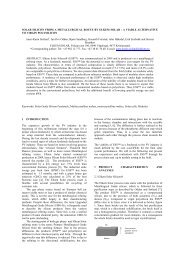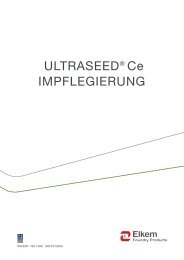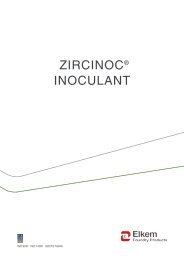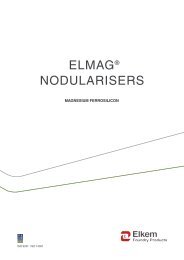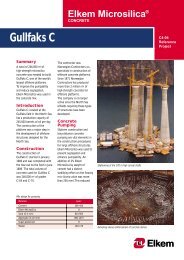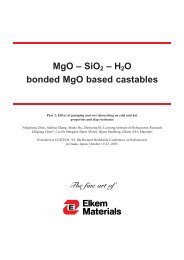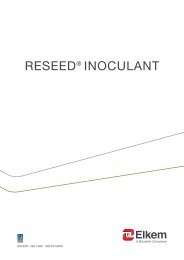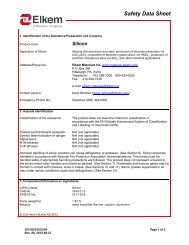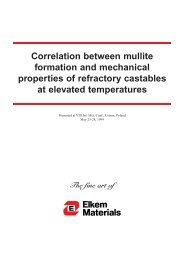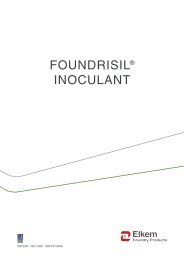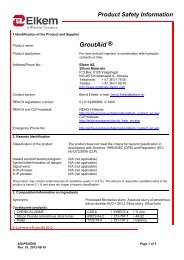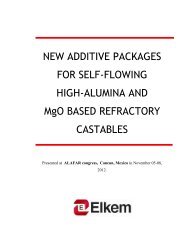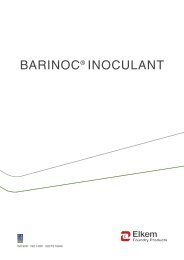ageing of refractory castables; which interactions exist and ... - Elkem
ageing of refractory castables; which interactions exist and ... - Elkem
ageing of refractory castables; which interactions exist and ... - Elkem
- No tags were found...
You also want an ePaper? Increase the reach of your titles
YUMPU automatically turns print PDFs into web optimized ePapers that Google loves.
AGEING OF REFRACTORYCASTABLES; WHICHINTERACTIONS EXIST ANDWHAT CAN BE DONE IN ORDERTO INCREASE SHELF-LIFE?Presented at 54 th International Colloquium on Refractories at Aachen, Germany in October19-20, 2011.
AGEING OF REFRACTORY CASTABLES; WHICH INTERACTIONS EXIST AND WHATCAN BE DONE IN ORDER TO INCREASE SHELF LIFE?Bjørn Myhre <strong>and</strong> Hong Peng; <strong>Elkem</strong> Silicon MaterialsABSTRACT:Ageing <strong>of</strong> <strong>castables</strong> is a well known problem that has beenattributed to <strong>interactions</strong> between cement <strong>and</strong> humidity. Inthe present study, commercial castable mixes have beentested before <strong>and</strong> after storage. Ageing experiments withoutingredients showed that additives do together with humidityreact with the cement. The <strong>ageing</strong> manifests as a gradual loss<strong>of</strong> self-flow combined with a retarded set time. Ifhexametaphosphate is used as deflocculant, there areindications <strong>of</strong> reactions between the phosphate <strong>and</strong> thecement or other ingredients during the <strong>ageing</strong>. The access <strong>of</strong>humidity is still a determining factor though. This additional<strong>ageing</strong> effect caused by the phosphate can be minimised byuse <strong>of</strong> other dispersing systems, here the novel dispersantSioxX/SioxX-quick is suggested. Substitution <strong>of</strong> the additivepackage leads not only to an improved shelf life, but also toa better flow for the tested castable compositions.INTRODUCTION:Ageing <strong>of</strong> LCC as phenomenon has been mentioned inpublications repeatedly by mainly the cement manufacturers.The <strong>ageing</strong> is primarily observed as a prolongation <strong>of</strong> thesetting time, sometimes connected to loss <strong>of</strong> flow. At somestage, the set gets so delayed that use <strong>of</strong> the bagged LCCgets difficult. This is <strong>of</strong> course a big concern for themanufacturers <strong>and</strong> the different <strong>refractory</strong> companies havedifferent approaches to get around this. Little <strong>of</strong> this activityis however available in literature probably due to its obviouscommercial aspects. So much (most?) <strong>of</strong> the knowledgerelated to <strong>ageing</strong> may remain hidden as proprietaryinformation. Due to reductions in research staff in the<strong>refractory</strong> industry, more problems related to <strong>refractory</strong> rawmaterials have been addressed to the raw-material suppliers<strong>and</strong> hence the <strong>ageing</strong> question has to some extent “bouncedback“ to the cement producers. The two large CA-cementmanufacturers Almatis <strong>and</strong> Kerneos seem to have followedseparate strategies to deal with the cement <strong>ageing</strong> though.While Kerneos has presented investigations on themechanisms behind the observed <strong>ageing</strong> 1,2,3 Almatis seemsto have followed a route that focused on packaging <strong>and</strong>documentation <strong>of</strong> their cements ability to be stored forextended time without degradation 4 , 5 Eventually these twostrategies, almost simultaneously led to introduction <strong>of</strong> newproducts with improved storage properties. The Almatisapproach has been in the packing, using plastic bags, whilethe Kerneos approach has been based on manufacturingcement that is less prone to <strong>ageing</strong> itself 6 .The above cited papers generally agree that it is the cementthat ages <strong>and</strong> the <strong>ageing</strong> is mainly caused by humidityreacting with the surface <strong>of</strong> the cement. Some reaction withCO 2 has also been noticed; however the main culprit hereseems to be the humidity. The exact contribution <strong>of</strong> thehumidity to the <strong>ageing</strong> has not been entirely mapped, but asthe loss <strong>of</strong> ignition <strong>of</strong> the cement seems to relate to theincrease in setting time that the <strong>ageing</strong> causes, its is temptingto think that the humidity causes the cement particles to react<strong>and</strong> produce a hydrate surface-skin that prevents the cementfrom dissolving <strong>and</strong> thus increases the set time.The dispersant that is used has also been found to havepr<strong>of</strong>ound influence on <strong>ageing</strong> 7 .EXPERIMENTAL PROCEDURE:The results that will be presented are mainly self-flow value<strong>and</strong> set time.The self flow is measured by filling the freshly mixedcastable (4 minutes wet-mixing) into the flow-conedescribed by ASTM C230 (5cm tall, NOT the more recentdescribed cone <strong>of</strong> 8cm(EN 1402-4:2003) The self flow valueis the %spread <strong>of</strong> the patty 1.5minutes after removing thebrass-cone.Set time is defined as the time to the first exotherm. This is<strong>of</strong>ten also referred to as the working time. As the measuredtime is dependent on initial temperature <strong>of</strong> the castable, thevales have been adjusted a start temperature to 22°C byusing adjustment based on empirical data for similarsystems.The <strong>castables</strong> were stored in a climate controlled room withstable temperature <strong>of</strong> 20°C <strong>and</strong> a relative humidity <strong>of</strong> above50% relative humidity or alternatively, in an unheatedwarehouse, dry but with fluctuating temperature.RESULTS AND DISCUSSION:The experiments that will be quoted in this paper are allcommercial mixes <strong>and</strong> the description <strong>of</strong> them willconsequently not be too detailed. However they will bedescribed in sufficient detail to make a fair assessmentpossible. The treatise will be as a ”case study“ presentingseveral cases each adding to the overall knowledge <strong>of</strong><strong>ageing</strong>:Case 1: Bauxite based LCCThe problem: Castables subjected to storage, deteriorates,particularly with respect to set-time <strong>which</strong> gets prolonged.Table 1 shows composition <strong>of</strong> the castable in question,bauxite based castable with calgon as additive <strong>and</strong> 4%cement.The castable was stored in the climate room or in anunheated warehouse. To check if interaction between thecomponents had an effect, raw materials were also stored inthe warehouse but individually packed. All the samples werestored in plastic lined paper bags. On the day <strong>of</strong> testing theindividually packed ingredients were combined <strong>and</strong> testedfor comparison.Table 1: Castable used in case-study 1:Microsilica (971U) 8Cement (70%CAC) 4Chinese Bauxite 68calcined alumina 20calgon 0.2water 5.5
Self-flow value [%]4540353025201510504141 413637351224Fresh 1 month 3months 6 months 12 months280Climate roomWarehouseIndividually packedFigure 1: The effect <strong>of</strong> storage conditions <strong>and</strong> duration onself-flow.In Figure 1, the self flow <strong>of</strong> the castable is shown for thedifferent conditions, <strong>and</strong> it is seen that flow decreasessignificantly with storage. Most severely reduced is the flow<strong>of</strong> the <strong>castables</strong> that have been stored under the humidclimate-room conditions, least severe are those that had notbeen assembled prior to storage. In other words, humidityseems to be a dominant factor here; <strong>which</strong> is in line with theprevious papers findings; but one cannot rule out that theremight be some <strong>interactions</strong> between the components thatincrease the <strong>ageing</strong> effect even further.Figure 2 shows the set time <strong>of</strong> the samples shown in Figure1.Set time [hours]302520151050Climate roomWarehouseIndividually packed6.456.45 6.4522159.68.3 8 7.975.74828>2525 >25 >2525 2523.65.95Fresh 1 month 3months 6 months 12 monthsFigure 2: The effect <strong>of</strong> storage <strong>and</strong> storage conditions on settime.Figure 2 shows beyond doubt that <strong>ageing</strong> is something thatshould be carefully considered for LCC’s. After even a shorttime the set time starts to increase <strong>and</strong> reaches levels thatmakes the castable practically useless. The packing <strong>and</strong>storage conditions are obviously important in this context.The assumption <strong>of</strong> humidity playing a major role seemsstrengthened as well. The important observation is that if theingredients are individually packed, the set time does notdeteriorate significantly. This must imply that there is somesort <strong>of</strong> interaction between two or more <strong>of</strong> the componentsduring storage that accelerates the <strong>ageing</strong>.Case 2: Self-flow SiC LCCThe next study is on a self-flowing castable based on SiC asaggregate <strong>and</strong> with 6% cement. The aim was to investigatepossible <strong>interactions</strong> between the individual ingredientsduring <strong>ageing</strong>. The test set-up was to mix the ingredientsexcept the one that was tested <strong>and</strong> then store the mix <strong>and</strong> themissing ingredient in the climate room for 9 months. Testingwas done fresh <strong>and</strong> after 9 months in the climate room. Theadditives (here Calgon + Alphabond) were stored in a sealedplastic box, i. e. not exposed to humidity.self flow value [%]1009080706050403020100Table 2: Castable used in study 2.Microsilica 10Cement 6SiC 72calcined alumina 12Calgon 0.2Alphabond 1water 5.5088 884970Full mix without MS without cement withoutadditives9288956fresh9 monthsFigure 3: The effect <strong>of</strong> <strong>ageing</strong> on self-flow for the mixesaged without certain ingredients.Set time [hours]80706050403020100>72 >7272 729.2 10.1 9.5 9.62.4fresh9 monthsFull mix without MS without cement withoutadditivesFigure 4: The effect <strong>of</strong> <strong>ageing</strong> on set-time for the mixes agedwithout certain ingredients.So, what do these results tell us? Figure 1 <strong>and</strong> 2 shows that<strong>ageing</strong> affects both self-flow <strong>and</strong> set time. The self flow getslower, <strong>and</strong> the set time increases. The figures indicate thathumidity plays an essential part in the <strong>ageing</strong>, as has beenfound in the earlier investigations cited above. It also25
Figure 5: Self-flow <strong>of</strong> SiC based self flowing LCC as afunction <strong>of</strong> additive package <strong>and</strong> storage. Samples stored athigh humidity in climate room.Figure 5 shows that flow degrades somewhat during the 3months storage time independent <strong>of</strong> the additive package.Interesting is to note the effect a change from Calgon(sodiumhexametaphosphate) to SioxX as deflocculantcauses, an increase in self flow from 92 to 120% for freshsamples. This is approximately 30% increase in self flow, asignificant increase as compared to that obtained by thephosphate. It is also very interesting that the addition <strong>of</strong>SioxX-quick to the castable does not influence flownegatively. This is a trait <strong>of</strong> many accelerators that has to betaken into consideration.Set time [hours]807060504030201006.3553.6>7232.327.33.35 2.7fresh1 Month3 Months2317.3Calgon SioxX SioxX/SioxX-quickFigure 6: Set time <strong>of</strong> SiC based self flowing LCC as afunction <strong>of</strong> additive package <strong>and</strong> storage. Samples stored athigh humidity in climate room.In Figure 6, the set time as measured by temperature isshown for the set <strong>of</strong> compositions <strong>and</strong> conditions. It isnoticed that the addition <strong>of</strong> SioxX-quick not only reduces theset time for fresh compositions, but also seems to decrease<strong>ageing</strong> somewhat. Form Figure 4, it may be estimated thatthe inherent setting time after storage without additiveshould be around 25 hours. This <strong>ageing</strong> was due to hydration<strong>of</strong> the cement etc. In Figure 6, the results with SioxX/SioxXquickget close to that number. Due to the differences inadditive package one should be careful not to draw too firmconclusions, but the results using SioxX is a majorimprovement as compared to results with the phosphate(Calgon).Based on the results presented in Figure 6, it seems fair tosay that additive/cement interaction are minimised if thephosphate dispersant system is replaced by the SioxXadditive package, <strong>and</strong> improved by use <strong>of</strong> SioxX-quick inconjunction with SioxX.cement hydrates, but additionally the additive reacts with thecement or some other constituent <strong>of</strong> the castable mix. Theresult is a very long setting. The obvious way to protect acastable mix from <strong>ageing</strong> is to keep humidity away. This canbe achieved by use <strong>of</strong> air-tight packing. In practise this maybecome both difficult <strong>and</strong> expensive though. The rightchoice <strong>of</strong> deflocculating system is an alternative way to easethe <strong>ageing</strong> even with moisture present. This was shown inthe examples utilising the SioxX/SioxX-quick additivesystem.1 Mathieu A., Bayoux J.P., Vialle M. ”Ageing <strong>of</strong> AluminousCement in LCC” proc. UNITECR 1995, Kyoto Japan p. 451-4552 Parr C., et al. „Ageing <strong>of</strong> Low Cement Castables“ proc.UNITECR 1997, New Olrleans USA, p. 81-893 Fryda H. et al. ”A new insight into the characterisation <strong>of</strong><strong>ageing</strong> <strong>and</strong> mechanisms that determine the shelf life <strong>of</strong> lowcement <strong>castables</strong>” proc. UNITECR 009, Salvador Brasil4 Gierish D., et al. ”Aging behaviour <strong>of</strong> Alphabond <strong>and</strong>Calcium Aluminate Cement bonded <strong>castables</strong>” proc. 49thInt. Coll. on Refr. Aachen 2006, p. 137-1425 Scmidtmeier D. et al. ” Cement Ageing: Something <strong>of</strong> thePast!” proc. 53rd Int. Coll. on Refr. Aachen 2010, p. 22-266 Parr C. et al. ”New Solutions to Increase the Shelf-life <strong>of</strong>Low Cement Castables” proc. 53rd Int. Coll. on Refr.Aachen 2010, p. 27-307 B.Myhre <strong>and</strong> H. Peng ”Effect <strong>of</strong> dispersants <strong>and</strong> rawmaterials on placing properties <strong>and</strong> shelf life <strong>of</strong> bauxitebased low <strong>and</strong> ultralow cement <strong>castables</strong>” proc. 53rd Int.Coll. on Refr. Aachen 2010, p. 62-668 B. Myhre <strong>and</strong> K. Sunde: “Alumina based <strong>castables</strong> withvery low contents <strong>of</strong> hydraulic compound. Part I: The effect<strong>of</strong> binder <strong>and</strong> particle-size distribution on flow <strong>and</strong> set”,Proc. UNITECR´95, Kyoto, Japan, Nov. 19-22, 1995, p.II/309-316CONCLUSIONAgeing <strong>of</strong> low-cement <strong>castables</strong> is a problem that most (all?)LCC manufacturers sooner or later will be confronted with.In the present paper, studies <strong>of</strong> <strong>ageing</strong> <strong>of</strong> two differentLCC’s have been presented, <strong>and</strong> the results confirm thathumidity is an important factor. This has previously beendescribed in literature. What is also found is that with thepresent phosphate dispersant (hexametaphosphate), reactionsbetween the dispersant <strong>and</strong> other components are <strong>of</strong>importance. Under the action <strong>of</strong> humidity, not only the



